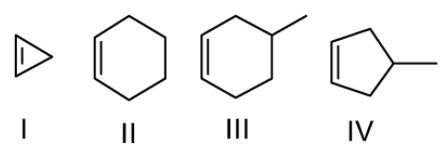
Answer
429.3k+ views
Hint: There are two criteria to decide stability of cycloalkene. One is hyperconjugation and the other is strain of the ring. Hyperconjugation is no bond resonance in which $\alpha $-hydrogen takes part. Higher the number of $\alpha $-hydrogens higher will be the number of hyperconjugative structures, higher will be the stability of alkenes. In cycloalkene compounds the ring is planar and that creates strain because the bond angle is less than that actually should have been and that strain makes the ring unstable. Higher the strain, less stable will be the cycloalkene.
Complete step by step answer:
- Cyclopropene(I): In cyclopropene carbons forming double bonds are $s{{p}^{2}}$ hybridized, so bond angle should have been ${{120}^{0}}$ but ring’s geometry is of equilateral triangle and it means bond angle becomes${{60}^{0}}$.
Strain= ${{120}^{0}}-{{60}^{0}}$
Strain= ${{60}^{0}}$
- Cyclohexene(II): In cyclohexane carbons forming double bonds are $s{{p}^{2}}$ hybridized, so bond angle should have been ${{120}^{0}}$ but ring’s geometry is of regular hexagon and it means bond angle becomes${{120}^{0}}$ .
Strain= ${{120}^{0}}-{{120}^{0}}$
Strain= ${{0}^{0}}$
- 3-methylCyclohexene(III): In 3-methylcyclohexene carbons forming double bonds are $s{{p}^{2}}$ hybridized, so bond angle should have been ${{120}^{0}}$ but ring’s geometry is of regular hexagon and it means bond angle becomes ${{120}^{0}}$.
Strain= ${{120}^{0}}-{{120}^{0}}$
Strain= ${{0}^{0}}$
- 3-methylCyclopentene(IV): In 3-methylcyclopentene carbons forming double bonds are $s{{p}^{2}}$ hybridized, so bond angle should have been ${{120}^{0}}$ but ring’s geometry is of regular pentagon and it means bond angle becomes ${{108}^{0}}$.
Strain= ${{120}^{0}}-{{108}^{0}}$
Strain= ${{12}^{0}}$
- Now if we compare the stabilities of cycloalkenes, the difference between stability of I and II is more than III and IV because strain difference in I and II is more than the III and IV
The correct answer is option “A” .
Additional Information : In spite of having 2$\pi $ electrons, cyclopropene doesn’t show resonance because in it delocalization of electrons doesn’t take place.
Note: Hyperconjugation is the stabilizing interaction that results from the interaction of the electrons in a C-H $\sigma $-bond with an adjacent empty or partially filled p-orbital or a $\pi $-orbital to give an extended molecular orbital that increases the stability of the system.
Complete step by step answer:
- Cyclopropene(I): In cyclopropene carbons forming double bonds are $s{{p}^{2}}$ hybridized, so bond angle should have been ${{120}^{0}}$ but ring’s geometry is of equilateral triangle and it means bond angle becomes${{60}^{0}}$.
Strain= ${{120}^{0}}-{{60}^{0}}$
Strain= ${{60}^{0}}$
- Cyclohexene(II): In cyclohexane carbons forming double bonds are $s{{p}^{2}}$ hybridized, so bond angle should have been ${{120}^{0}}$ but ring’s geometry is of regular hexagon and it means bond angle becomes${{120}^{0}}$ .
Strain= ${{120}^{0}}-{{120}^{0}}$
Strain= ${{0}^{0}}$
- 3-methylCyclohexene(III): In 3-methylcyclohexene carbons forming double bonds are $s{{p}^{2}}$ hybridized, so bond angle should have been ${{120}^{0}}$ but ring’s geometry is of regular hexagon and it means bond angle becomes ${{120}^{0}}$.
Strain= ${{120}^{0}}-{{120}^{0}}$
Strain= ${{0}^{0}}$
- 3-methylCyclopentene(IV): In 3-methylcyclopentene carbons forming double bonds are $s{{p}^{2}}$ hybridized, so bond angle should have been ${{120}^{0}}$ but ring’s geometry is of regular pentagon and it means bond angle becomes ${{108}^{0}}$.
Strain= ${{120}^{0}}-{{108}^{0}}$
Strain= ${{12}^{0}}$
- Now if we compare the stabilities of cycloalkenes, the difference between stability of I and II is more than III and IV because strain difference in I and II is more than the III and IV
The correct answer is option “A” .
Additional Information : In spite of having 2$\pi $ electrons, cyclopropene doesn’t show resonance because in it delocalization of electrons doesn’t take place.
Note: Hyperconjugation is the stabilizing interaction that results from the interaction of the electrons in a C-H $\sigma $-bond with an adjacent empty or partially filled p-orbital or a $\pi $-orbital to give an extended molecular orbital that increases the stability of the system.
Recently Updated Pages
Who among the following was the religious guru of class 7 social science CBSE

what is the correct chronological order of the following class 10 social science CBSE

Which of the following was not the actual cause for class 10 social science CBSE

Which of the following statements is not correct A class 10 social science CBSE

Which of the following leaders was not present in the class 10 social science CBSE

Garampani Sanctuary is located at A Diphu Assam B Gangtok class 10 social science CBSE

Trending doubts
A rainbow has circular shape because A The earth is class 11 physics CBSE

Fill the blanks with the suitable prepositions 1 The class 9 english CBSE

Which are the Top 10 Largest Countries of the World?

How do you graph the function fx 4x class 9 maths CBSE

The Equation xxx + 2 is Satisfied when x is Equal to Class 10 Maths

What is BLO What is the full form of BLO class 8 social science CBSE

Change the following sentences into negative and interrogative class 10 english CBSE

Give 10 examples for herbs , shrubs , climbers , creepers

Difference between Prokaryotic cell and Eukaryotic class 11 biology CBSE





